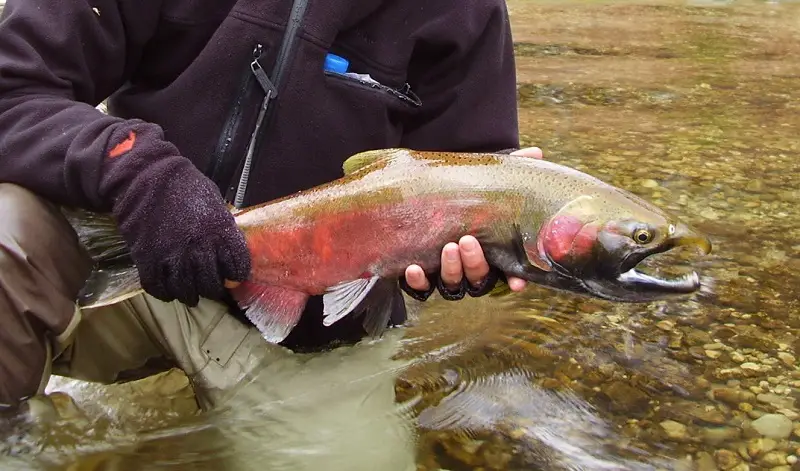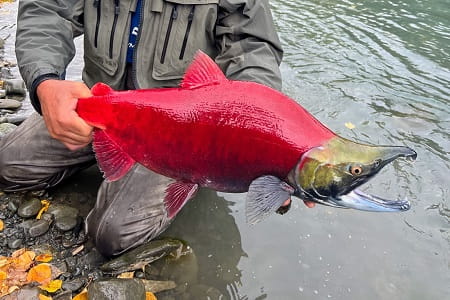Dipnetting For Salmon: A Complete Guide

1. Introduction to Dipnetting For Salmon
Dipnetting for salmon is a technique that involves using a large, handheld net to catch fish, particularly salmon, during their spawning migrations has roots in indigenous fishing practices and has evolved into a popular recreational activity in regions like Alaska.
The thrill of catching all salmon species and the bonding it fosters among participants contribute to its popularity, while also presenting numerous challenges such as understanding fish migration patterns and mastering the technique.
Dipnetting is used to catch most salmon species with Sockeye Salmon and Coho salmon the most popular. Even very large King salmon can also be netted.
2. Essential Gear and Equipment For Dipnetting For Salmon

Dipnetting necessitates a range of essential gear, including a sturdy dipnet, durable waders, coolers for storing the catch, and protective clothing. Selecting the right gear involves considering factors like durability, ease of use, and effectiveness in the specific fishing environment.
Furthermore, proper care and maintenance of the gear are crucial to ensure its longevity and effectiveness in subsequent dipnetting expeditions.
Other methods for fishing salmon in Alaska can be used where dipnetting takes place.
3. Techniques and Strategies for Dipnetting For Salmon
Understanding the basic techniques and strategies for successful dipnetting, such as choosing the right time of day, understanding salmon migration patterns, and positioning oneself optimally in the water, is key.
Gaining insights into the behavior, migration patterns, and habitats of salmon enhances the success rate and ensures a respectful interaction with the species.
4. Locations for Dip Net Fishing in Alaska
It can get crowded in many areas, especially near the river mouths.
Alaska boasts numerous locations for dipnetting, including some popular dipnetting locations in Alaska:
- Kenai River: This is one of the most popular dipnetting locations in Alaska, especially known for its salmon runs.
- Kasilof River: Another popular spot, the Kasilof River, offers opportunities for dipnetting, particularly for sockeye salmon.
- Copper River: The Copper River is renowned for its rich and flavorful salmon, making it a favored spot for dipnetting.
- Fish Creek: This location is known for its late-season salmon runs, providing opportunities for dipnetting later in the summer.
- Chitina River: A part of the Copper River system, Chitina also offers opportunities for dipnetting amidst stunning natural scenery.
- Twentymile River: Accessible from the Seward Highway, Twentymile River is another spot where Alaskans can engage in personal use dipnetting.
- China Poot Bay: Located near Homer, this spot is known for its hooligan (eulachon) run, and it’s a popular dipnetting location in the spring.
- Susitna River: Offering various spots for dipnetting, the Susitna River is another location that Alaskans frequent for this activity.
- Knik River: Known for its hooligan runs, the Knik River is a favored spot for those looking to dipnet this particular species.
- Yentna River: A tributary of the Susitna River, Yentna also provides opportunities for dipnetting in a beautiful Alaskan setting.
Selecting a dipnetting location involves considering factors like accessibility, fish population, and local regulations. It’s vital to respect the local communities and their lands while engaging in dip netting, ensuring that the activity does not disrupt their lives and environment.
5. Safety and Precautions For Dipnetting For Salmon
Ensuring safety while dipnetting involves being mindful of the environmental conditions, using gear correctly, and being aware of the surroundings.
Understanding the potential risks, such as water currents, weather conditions, and wildlife, is crucial to mitigating them and ensuring a safe dipnetting experience.
Being prepared for emergencies, such as injuries or unexpected weather changes, ensures that participants can effectively handle unforeseen situations.
6. Legal Framework and Regulations
Engaging in dipnetting requires strict adherence to specific legal frameworks to ensure the activity is conducted sustainably and ethically. The Alaska Department of Fish and Game (ADF&G) plays a pivotal role in regulating dipnetting activities, establishing rules, and ensuring the conservation of fish populations.
Abiding by regulations is paramount to ensuring the sustainability of fish populations, protecting ecosystems, and preserving the practice for future generations.
7. Ethical and Sustainable Dipnetting
Engaging in ethical dipnetting involves respecting the species, adhering to regulations, and ensuring that the activity does not harm the ecosystem.
Sustainability in dipnetting involves practices like catch and release, adhering to quotas, and ensuring that the activity does not negatively impact fish populations. Utilizing gear and techniques that minimize impact on the environment and species ensures that dipnetting can be enjoyed by future generations.
Dipnetting is open to residents of Alaska only! Nonresidents are not permitted to participate in the dipnet fishery in any way, which includes handling the gear, cleaning the fish, or using the dip net.
NOTE: This is only a guide to Dipnetting for salmon. Conditions, rules, and regulations can change at any time, so check the official Alaska Fish And Game website for full details.
8. Processing and Utilizing the Catch
Once caught, salmon should be processed efficiently, involving cleaning, filleting, and preserving the fish to ensure no wastage. Techniques like smoking, canning, and freezing allow the catch to be preserved and utilized over an extended period. Ensuring that all parts of the salmon are utilized effectively minimizes waste and respects the catch.
9. Conclusion
In conclusion, dipnetting for salmon in Alaska is not only a recreational activity but also a practice steeped in tradition and community. By adhering to regulations, respecting the environment and local communities, and practicing safe and ethical fishing, dipnetting can continue to be a sustainable and enjoyable activity for generations to come.
Tight Lines
Graham
Sources:
- Trooper Citations for Salmon Discards Add Grist to Regional Alaska Fishery Dispute
- Discusses citations issued for dumping unwanted salmon in Area M, potentially impacting Yukon and Kuskokwim rivers’ salmon.
- Frequently Asked Questions About a New Federal Salmon Fishing Opportunity in the Lower Copper River
- Provides information on allowed gear for salmon dipnetting in the Lower Copper River Area.
- Dipnetting 2021 – Northern Expenditure
- A personal account and methods of dipnetting in 2021.
- Kenai River Dipnetting Information – Alaska Outdoors Supersite
- Offers comprehensive information about dipnetting in the Kenai River.
